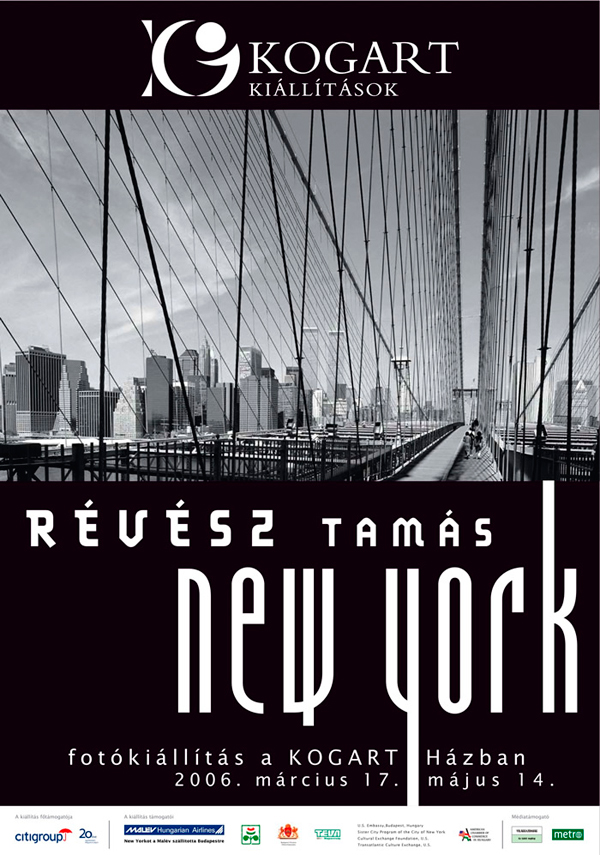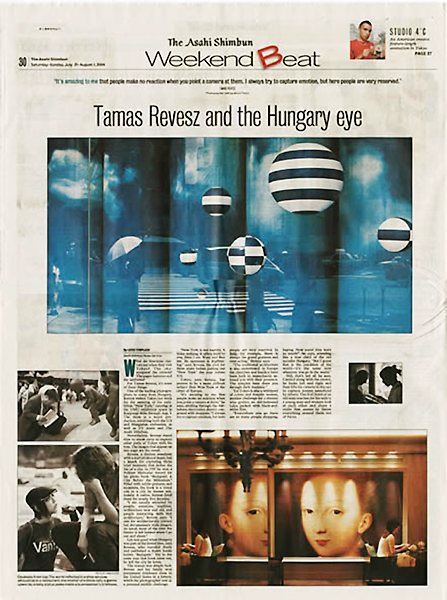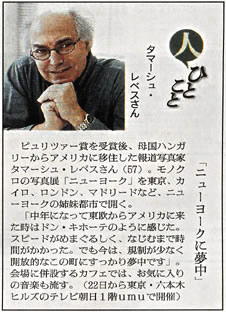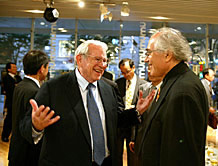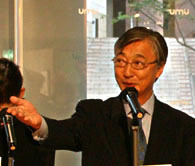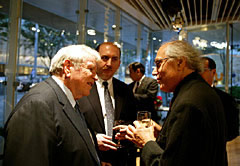REVIEWS / Tamas Revesz “His vision is purely Hungarian and his photos show the liberating dynamic of diversity. Revesz, a tireless wanderer with a mad professor mane, has a knack for capturing those brief moments that define the life of a city.” – International Herald Tribune/Asahi Shimbun “An intriguing blend of fresh eyes and a Central European wit that reflects the look and spirit of New York at the turn of century. At first glance [the photographs] look like they are about one thing, when on closer examination it emerges that they are actually about something else altogether. This dichotomy has become Revesz’s trademark.” – Cornell Capa, Founder and Director Emeritus , International Center of Photography, New York “Revesz has brought a new perspective to the black-and-white New York cityscape and urban scene genre (no small feat considering how many photographers have covered this ground before). Where others have looked at New York and seen only the weighty hand of modernity (Stieglitz, et al) or our pathetic attempts to escape it through entertainment, revelry, even crime (Weegee, et al), you've found some timeless magic, and perhaps even - yes - transcendence…” – Peter Shevenell, Art Director, JCCA, New York “Some of the most beguiling and intriguing photographs of New York City ever taken. With a photographic eye not unlike of his fellow countryman, André Kertesz, Revesz captures the essence of the city in an often surprising way. The poetry and charm of these images will speak both to New Yorkers and visitors alike.” – Jim Mairs, Editor and Vice President, W.W. Norton, New York “Tamas had distinguished himself internationally by both his work and his cosmopolitan spirit. His mixture of sensitivity and infinite curiosity for the human condition makes him one of the most important photographers of ‘The Family of Man’ today. The world of art and photography and the culture and people of his adopted country, the United States, are extremely fortunate to have had this brilliant new ‘immigrant’ arrive among them.” – Peter Turnley, award-winning photographer, New York “The exhibition at Leica Gallery celebrates the publication of Revesz’s new book, “New York” (W.W. Norton), a captivating selection of photographs showing New York City from a fresh perspective.” – Rose and Jay Deutsch, Directors, Leica Gallery, New York “These New York gelatin silver photographs are handsome, clever and witty. Frequently they document encounters between the citizens of this city and the odd objects we find here daily. Revesz has a wonderful instinct for finding the visual accents that constantly enliven our city as New Yorkers encounter each other and our bizarre urban artifacts.” – Richard McBee, art critic, New York “Clearly Mr. Revesz now belongs to New York in the sense that he has managed to perfectly capture the very spirit of the city in this series of beautiful photographs. Of course, his technique is fantastic. Beyond that, however, one has to be impressed by the extent to which each photograph reveals the complexity of New York and tells us a story about the city and its people.” – Hon. Howard Baker, U.S. Ambassador to Japan “Francis Bacon, the great British painter, said that it was the reflections of the glass that allowed you to enter and be part of an image – but here, with these Piezography prints, you are, in effect, already inside the image. You feel part of it. It is not only about light and composition, lines and aesthetics. It is about air and the warmth. It is a sense of intimacy, of sensuality, with no mediation but that of our imagination.” – Robert Pledge, President, Contact Press Images, New York Reviews - New York exhibition in Kogart (Budapest)
"Végre nem a felhőkarcolók
ájulata: a Nagy Alma embermagasságból. Az
igen ritka régi épületek bájosan gubbasztanak
a százemeletek tövében. Révész Tamás
éber optikával figyel, a sohoi kávéház
ablakában ujságjába mélyedő polgárnál
jobban érdekli a kép másik fele, a kutyája
hasát dögönyöző járókelővel.
Üveglámpást dárdaként tartó
giccs-lovag és egy kedvesen cicomás épület
- hát nem feltűnik mellette egy porszívócsövét
nyakára hurkoló férfi... A Madison Green képe
Kertészt idézi, de az ellenfényben rácsos
árnyékot vető szemétkosár, a
Brooklyn-híd elött sütkérező kerékpáros
lány, a Két Toronnyal a háttérben, vagy
a Central Park magányos sífutója, a havon
kirajzolódó csupasz ág-koronákkal: - egy
jeles fotográfus művészi arcélének
egyedi lenyomata. Meghatóak a halványszürkék,
soha nem komor a fekete, a részletek élesek, mégis
valami poétikus lebegés hatja át a képeket.
Nyugalom és fenség, az érett arányok
mennyei csöndje. Mintha ez a varázsos város csak
fényben és derűben úszna. A Brooklyn-híd
gótívű kapuja alatt anyuka sétál gyermekével,
bedeszkázott ablakú ház elött férfiak:
talán a Florida, a Paradicsomba igyekeznek. Aztán
a megrázó mementó: púpos uszályhídak
mögött diadalmasan, a Liberty Parknál viharfelhőktől
övezve, végül egy havas temető sírkövei
fölött, derengő fényben magasodik a World Trade
Center. A fotográfia ünnepe a Kogart imponáló
terében, gyönyörűsége kiállítás!" "...Az építészet
régóta visszatérő alanya a festészetnek
és a fotográfiának, olyan téma, mely egyszerre
képes felidézni ember alkotta természetünket,
és az épített környezetben élő
ember tapasztalatait, emlékeit az őt körülvevő
térről. "2000-ben jelent meg Révész Tamás New York címû fotóalbuma, borítóján komor felhőkbe fúródnak a Világkereskedelmi Központ ikertornyai, az égbolton egy sirály billeg feléjük. Belül, újabb nézőpontból az ikertornyok egy temetô sírkövei közül kandikálnak ki. Egy év múlva, 2001. szeptember 11-én a baljóslatú felvételek valamennyi négyzetcentimétere, tónusa értelmet kapott, és anélkül, hogy túlzásokba esnénk Révész művészi érzékenységét illetően, ki kell jelentenünk: ilyen kényes receptorokkal alighanem csak kevés alkotó rendelkezik. Miközben itthon és külföldön több fontos albuma jelent meg, elismeréseket, köztük Pulitzer-emlékdíjat kapott, 1996-ban egy New York-i kiállításán megkérdezték tőle, mit tervez mostanában, ő azt válaszolta: könyvet fog fényképezni New York-ról. Kinevették: ez szamárság. New York le van fényképezve. Minden épülete, valamennyi kiszögellése, tetoválása, bibircsókja. Révész mégis nekilátott. Három évig fotózta a várost, azt mondja: ugyan friss szemmel, de kevés ismerettel és naiv hittel ugrott neki a reménytelennek tetsző vállalkozásnak. A végeredmény azonban az egyik magasan jegyzett helyi kiadót is meggyőzte: az anyagból könyv lett, a felvételekből pedig kiállítási anyag, amelyet először 2004-ben Tokióban mutattak be, most pedig május 14-éig Budapesten, a KOGART Házban, hogy aztán a tárlat tovább utazzon Pekingbe, Kairóba, Jeruzsálembe, Johannesburgba, Londonba, Madridba, Rómába és Santa Domingo-ba. Különleges technikával, merített papírra nyomott képek New York-ról, az időtlenségre kihegyezve. A sokszínű helybéliek, a helyszínt hitelesítô csillogás, a közhelyes és agyoncsócsált napi kalandok nélkül. New York, mint geometrikus rend, amelyben az emberek korántsem főszereplők. Csupán a daliás díszletrendszer statisztái. – Még sehol sem éreztem az embert ennyire kicsinek, szegénynek és törékenynek, mint ott – mondja Révész, aki tíz éve többnyire maga is Amerikában él. Hozzáteszi még: a képek azért fekete-fehérek, mert úgy érzete, ezzel lehetett azokat időtlenné, maradandóvá tenni, kiemelni a pillanatnyi divattrendek harsogásából, a jelen fortyogásából. A Park Avenue fényei, a Central Park nyugalma, a reklámlány mosolya mögül előmeredő Chrysler Building, vonalkódot idéző tűzlépcsők, vagy a gyufaszálakból összepilinckázott makettre emlékeztető George Washington híd, amelynek tövében egy bolhányi emberpár éppen csókot vált. Hatvankét kép. A New York nevű sakktábla
hatvankét kockája. Kettő nincs meg, 2001. szeptembere
óta hiányzik. Révész képei őrzik az emlékét." "NEW YORK CSÖNDES
LOBOGÁSA Révész képein redőnylamellák és függesztőkábelek, korlátoszlopok és ablaknégyszögek hirdetik a tervezés egyik alapműveletének, a mennyiségi sokszorozásnak az egyeduralmát. Bár a magasépületek, e megkövesedett oszlopdiagramok, az élet kiszámíthatóságát (és kiszámítandóságát) hirdetik, New York utcáin az oda látogatót mégis az élet kiismerhetetlenül örvénylő tarkabarkasága fogadja. A rikító színek, az ezerféle zaj, a magukat kelletőárucikkek, az időtlen tekintetű próbababák vagy a sok emelet magasban lebegő arcok mit sem enyhítenek a jövevény magányán: legfeljebb annyit, mint a tükörképek a homlokzatok üvegén. Ezért aztán ha a park fái közül a magasba tekint, hajlamos az emberalkotta toronyházakat is földből sarjadzott növénykolosszusok kiszáradt törzseinek vagy szélcsiszolta sziklatömböknek, mindenestre természeti képzôdményeknek tekinteni. A nagyvárosi magány nem csak az ideszakadtak, a bevándorlók előjoga: bárki részesedhet belőle. Ám aki nem csupán átutazóként akarja benyomásait fotópapírra rögzíteni, de letelepedni szándékozik ebben a városban, annak a színpompás de fárasztó felszínnél többet kell megragadnia: olyasvalamit, amiből a város pezsgő művészeti élete táplálkozik. „Itt mindenki idegen, és senki se az. New Yorkot, mondják, senki se ismeri. Naponta változik, akár a tenger, egy pillanat alatt »fölfogható«, s akár a tenger, öröktôl ismerôs.”, írta Pilinszky. A Párizsból ideköltözött, s jó két évtizede halott André Kertész nyomdokában járó, s talán épp ezért a színeket elhagyó, a hangosfilmet némafilmre cserélő Révész épp ezt a mélyben rejlő különös transzcendenciát kereste és találta meg a fekete-fehér New Yorkban. A sebezhetetlennek hitt várost olyan hihetetlen támadás
érte, amire, mint kiderült, nem volt felkészülve.
Csapást mértek egy szimbólumra, s ezzel megtört
az időtlensége, az idő felettisége: a történelem
egy beláthatatlan eseménysor kiindulópontjává
tette. Ma már nem tudjuk szorongás nélkül
nézni Révész kötetének címlapján
a Világkereskedelmi Központ tornyait: baljós felhőzet
alatt sötét vaskerék, a levegőben egy felzavart
sirály. Megint csak Pilinszky elbeszélőjének szavai
kívánkoznak ide: „Egy biztos. Erről a városról
bármit megfogalmazok, frivolnak hat. Vázlatosnak. Vagy
maga is az? Igen, maga a város is az. És mégse.
Épp ellenkezôleg. Hiába a szörnyeteg ragyogás,
New York egyetlen gyertyaláng. Ez áll a kéziratban
is: »New York magában égő gyertyaszál.«” "A vándorkiállítás
hazatért. Révész Tamás New York című
kiállításának némelyik képéről
nehéz megmondani, hogy New York-ban, Londonban vagy Kôbányán
készült-e. A fekete-fehér fotók sajátos
hangulata azonban azonnal megfogja a látogatót a Kogart
Ház elegáns galériájában. Révész
Tamás szerint látszólag "elmebeteg ötlet"
volt feladnia az itthoni biztos egzisztenciát, kimennie Amerikába,
és amerikaiaknak Amerikát fotózni. Amikor ottani
fotós barátainak elmondta, hogy New Yorkról akar
albumot készíteni, szabályosan kiröhögték.
De végül neki lett igaza: több mint tíz éve
él már kint, sikeres és világszerte elismert
fényképész lett, New York-anyaga pedig utazó
kiállítás, most érkezett hazánkba." "Az immáron hatvanegyedik
életévét taposó Révész Tamás
a klasszikus magyar sajtófotósok útját járja,
bár kissé megkésve. Miután 1997-ben kitelepült
Amerikába, elkezdett dolgozni New York-sorozatán. New
Yorkról már mindent elmondtak – de persze van olyan
nagy és végeláthatatlan, hogy sose lehessen róla
mindent elmondani. Révész megszülte hát saját
olvasatát a nyughatatlan metropoliszról. Hűvös
fekete-fehér képnyelve, erősen geometrikus szerkesztésmódja
és emblémaszerűen frappáns jelenetei egy
csapásra klasszikussá avatták felvételeit...Persze
az ismertség egyik motorja a politika: a diplomáciának
jól jönnek a meredező ikertornyok és a lengedező
amerikai zászlók, főként egy őszinte
bevándorlótól. De ez nem sokat von le a New York-album
értékéből, Révész a klasszikus
humanista fotósok útját követi (André
Kertész, Brassai és társaik): kiszámított
fény-árnyék hatások, gondos komponálás
és a megfelelô időpont, a „termékeny
pillanat”. Annyit még tegyünk hozzá, hogy Révészt
elsősorban az architekturális New York bûvöli
el, a vízszintesek és függőlegesek mérnöki
rendje, s kevesebb szót veszteget a felhőkarcolók
és bérházak közt élő polgárok
millióira." "A 9 éve Amerikában
élő, díjakat halmozó fotográfus-tanár
készített már albumot Siófokról,
Szicíliáról, Rómáról, Budapestrôl.
Mostani, New Yorkot bemutató fekete-fehér anyaga nagy
ívben elkerüli a közhelyeket: ne számítsunk
csillogó forgatagra vagy csupa mosoly emberekre. "...A híres amerikai fotográfus, Peter Turnley szerint: „Révész munkáiban számos magyar elődjének – Brassai, Capa, Kertész és Moholy-Nagy – szelleme fedezhető fel. A magyar fotográfusok speciális látásmódjukkal egy különös művészeti vonulatot képeznek, és ez segít megmagyarázni univerzális varázsukat, sikerüket a világban. Az erőteljes, tiszta és őszinte látásmód, a magyar érzékenység és a világpolgári életszemlélet együttes jelenléte teszi képessé ôket arra, hogy meglássák és megörökítsék azt, ami csak a lélek számára felfogható. Révész megörökölte ezt a kincset, ami képein jól nyomon követhető. A művész által választott ország rendkívül szerencsés, hogy egy ilyen briliáns tehetséggel gyarapodik.” Révész Tamás 1997 óta él New Yorkban. Mint mondta: „Szerencsésnek érzem magam, hogy otthon vagyok mind Magyarországon, mind Amerikában és így valamilyen módon mindkét ország hozzájárul az alkotásaimhoz. Fotóit világszerte kiállítják, tíz albuma jelent meg magyar, angol, francia, olasz és orosz nyelven. A New York sorozatot Révész Tamás három
éven át készítette. Egyedi, sokszor lírai
megközelítése kerüli a közhelyeket, fotói
minden esetben saját véleményét tükrözik,
nem pusztán egy esemény, egy látvány riporteri
megjelenítései. A felszín helyett a mélység,
a mögöttes tartalom érdekli igazán. Témaválasztásaiban
egyfajta szociális érzékenység vezeti, kompozíciói
a vizuálisan felfogható jelek segítségével
érzelmeket, szubjektív állásfoglalásokat
sugallnak, és ezek adják a képek igazi értékét.
Látásmódjában a különböző
építészeti elemek határozott síkjai
és vonalai szinte éreztetik a város lüktetését,
dinamikáját, melyekben ötvöződik az architektonikus
és a dokumentarista fotográfia. A vízszintesek
a függőlegesekkel, a fény az árnyékkal,
az élő az élettelennel, a beton a növényi
organizmussal kerül kapcsolatba. Az óriási tornyok
és az egy ritmusra épülő hidak rengetegében
pedig eltörpül az élő, alkotó ember, aki
mindezt létrehozta." Reviews in English "There is a photographer here, with us, who is half American and a half Hungarian or – probably – completely Hungarian. Who is spite of this is looking at the world as a Central-European and as a cosmopolitan, and he possesses the technical skill to show us what he can see. Being a practicing photographer myself I dare to say that to see and to show are two different things. As to what does Tamás RÉVÉSZ want to show? As he worded it, he tries to grasp and to reflect the so-called genius loci, namely the spirit of the place. Many say that his photos are shocking. I would rather say that his photos are shocking because they are spontaneous, witty and timeless, because he presents even the ugly as being beautiful. And with doing so, he is completely in opposition with the fashionable trends which try to make ugly even the beautiful.
"...New
York, through Hungarian eyes. "...New
York vision. Hungarian’s take on Big Apple even grabs
local’s attention...“I am usually attracted by people, emotions,
tradition, architecture new and old, and people interacting with that
architecture” Révész said at the exhibition’s
opening, adding however that the theory is often left behind when he
actually goes out to shoot. “My photographs have retained a documentary
style... His first photo book was Bidding Farewell to a Gypsy Colony
in 1977, followed later by documentary photographs in Ecuador for the
United Nations. Something other The New York photos have won critical acclaim in the
city itself for their documentation of citizens’ encounters with
bizarre urban artifacts. One photograph in particular has attracted
attention for what now seems a prophetic message: a shot of the World
Trade Center twin towers with a cemetery in the foreground. “Where
others have looked at New York and seen only the weighty hand of modernity
(Stieglitz, et al) or our pathetic attempts to escape it through entertainment,
revelry, even crime (Weegee, et al), you've found some timeless magic,
and perhaps even - yes - transcendence,” wrote Peter Shevenell,
art director of Jewish organisation JCCA." Turning sixty this year, photographer Tamás Révész
is now living in New York City. He flew across the ocean, like Környei,
the narrator of Pilinszky’s Conversations with Sheryl Sutton,
who wanted to write the history of New York. Yet, it was to no avail
to read so much on the subject and to roam the avenues with eyes wide
open. He had to acknowledge defeat because the throbbing city of skyscraper
cathedrals has only a present. Since it has always been driven by the
same desire, past here is not the cause of the future. Pressed into
the shape of the present, the past is as much coordinated with the present
as the old buildings in the shade of the glass palaces, or the myriad
complexions, customs and cultures in the boiling streets. What the storywriter
cannot capture can be seized by the one whose profession is the present
frozen into timelessness: the photographer.The
lifelessness of the still grey buildings that fill the grid is in strange
contrast with the organic quality of the whole formation. The traffic
that moves along the ruler-drawn street veins, regulated by traffic
light constrictors, is a metabolism driven by the necessity of repetition.
What is constantly changing seeks a timeless goal: homeostasis. New
York, the City, with its grids, laid out on the ground and then raised
towards the skies, is its own monument.With
the slats of Venetian blinds, suspension cables, railings and the rectangles
of windows, Révész pays homage to the dominance of a simple
procedure in design, quantitative multiplication. Though the high-rises,
these petrified block diagrams, advertise the predictability of life
(and the need to be prepared), the streets of New York welcome the visitor
with an inscrutable whirling motley of life. Loud colours, constant
noises, the goods for sale, the mannequins with their timeless gazes
or the faces floating several stories above the ground do little to
soften the newcomer’s loneliness; no more than the reflections
on the glass facades. So when looking up from among the trees of the
park, one is tempted to see the man-made skyscrapers as giant lifeless
trunks or wind-shaven rocks, natural phenomena in any case. Loneliness
in the city is not the privilege of those who drifted or emigrated here;
it is available for everyone. Yet he who wants to record on film more
than the impressions of a tourist, and wants to settle in the city,
needs to seize more than the colourful yet tiring surface – something
that feeds the city’s vibrant art life. “Everybody’s
a stranger here, and nobody is. Nobody, it is claimed, knows New York.
It changes every day like the sea, and just like the sea you can immediately
‘take it in,’ you have always been familiar with it,”
wrote Pilinszky. Following the example of André Kertész
who moved there from Paris and who had been dead for over ten years,
Révész, who exchanged colour motion picture for black-and-white
stills for probably the same reason, sought and found this deep-running
strange transcendence in New York.Supposedly
invulnerable, the city suffered a blow it was unprepared for. One of
its symbols was attacked, which shattered its timelessness, its imperviousness
to time. History made it the starting point of an incalculable series
of events. Consider Révész’ photograph of the World
Trade Center towers with the dark iron wheel, foreboding clouds and
roused gull in the air. We can no longer look at that photo on the cover
of Révész’s book without trepidation. Pilinszky’s
words are as cogent as ever: “One thing is for sure. All my phrases
about this city seem frivolous. Sketchy. Or is the city itself sketchy?
It is. And yet it isn’t. On the contrary. Despite the monstrous
brilliance, New York is but a candle flame. This is what I have in the
manuscript: ‘New York is a lonely candle.’” On March 17, 2006, Ambassador Walker opened the traveling photographic
exhibition of Pulitzer Memorial Award winning Hungarian photographer
Tamás Révész. The 62 black and white images of
New York arrived to Budapest with the help of the U.S. Embassy Budapest,
the U.S. Cultural Exchange Foundation, the Transatlantic Cultural Exchange
and the Sister City Program of the City of New York. Following their
showing in Hungary through May 3, the photographs will travel around
the world to Beijing, Cairo, Jerusalem, Johannesburg, London, Madrid,
Rome and Santo Domingo. In his opening remarks Budapest Mayor Gábor Demszky emphasized
that the artist's photos are surprising, sophisticated, witty, timeless,
and poetic. It is not only Tamás Révész's outstanding
technical expertise that makes these photos so unique but also his ability
to grasp and reflect the feeling and atmosphere of places. In a letter,
New York City Mayor Michael R. Bloomberg also praised the artist's special
gift for recognizing and capturing the blur of action, the energy and
discrete moments of the metropolis.Ambassador
Walker thanked KOGART gallery for hosting this one of a kind exhibition
and expressed how delighted he was that Tamás Révész
chose New York as the subject of his work. By doing so, the artist also
built and reinforced cultural connections between the people of Hungary
and of the United States through the power of the images. He also expressed
his hope that by looking at the photos more and more people would consider
the "Big Apple" as a vacation destination. Reviews of New York exhibition in Tokyo
Tamas
Revesz and the Hungary Eye "
It's amazing to me that people make no reaction when you point a camera at
them. I always try to capture emotion, but here people are very reserved."
Iconic Photo Exhibit Says "I Love NYC" The Asahi
Shimbun"New
York", an exhibition of about 60 black and white photos of the American
metropolis by prize-winning Hungarian photographer Tamas Revesz, opened Thursday
night at the UMU gallery in Tokyo's Roppongi district. -.Louis Templado, International Herald Tribune/Asahi Shimbun, July 23,2004
Remarks by Howard Baker, US Ambassador, Tokyo, Thursday, July 22, 2004
Organizers, sponsors and distinguished guests; It gives me great pleasure to be here to open this exhibit by the prize-winning photographer Tamas Revesz. The famous journalist and novelist Tom Wolfe once said: "One belongs to New York instantly. One belongs to it as much in five minutes as in five years." Clearly Mr. Revesz now "belongs to New York" in the sense that he has managed to perfectly capture the very spirit of the city in this series of beautiful photographs. Of course, his technique is fantastic. Beyond that, however, one has to be impressed by the extent to which each photograph reveals the complexity of New York and tells us a story about the city and its people. In his preface to the book, Mr. Revesz talks of the "liberating dynamic of diversity" that predominates in New York. To me this indicates the extent to which he understands the very nature of not only the city itself, but of US society in general. With these photographs, Mr. Revesz, himself a naturalized American, pays an awesome tribute to America's most famous city, and to the resilience and spirit for which New Yorkers have come to be known. My sincere thanks to the Asahi Shimbun for bringing this exhibit here to another incredible city. My hope is that by being here Mr. Revesz will be inspired to do a similar book on Tokyo. In the meantime, I hope you all enjoy this evening's opening and the beautiful photographs on display. Speech by Mr. Toshiyuki TAKAGI, Board of Directors, Asahi Shimbun
Thank you for coming to
the opening reception of “Tamas Revesz Photo Exhibition– New York”.
I would like to say a word representing the Asahi Shimbun. Remarks by Istvan Perosa, Minister, Hungarian Embassy, Tokyo
Hungarian photographers are widely known and recognized all over the world. André Kertész or Robert Capa, who had a highly successful exhibition here in Tokyo last fall, are household names among photo aficionados. People often wonder what makes these artists stand out from the crowd of talented photographers whose pictures we can see in the media or in exhibitions like this one day after day. Rumor has it that it is that special Hungarian approach, combining what’s visible to the human eye with what’s perceptible only to the human soul. I am confident that the pictures on display here today will prove to you all, beyond any doubt, the power of this visual sensitivity, characteristic of my fellow Hungarians. The pictures we are going to see today were shot by a Hungarian American, not by an American of Hungarian origin. I’ve made this distinction on purpose, since Mr. Révész had lived and worked in Hungary till 1997, when he won the right to become an American resident through Visa Lottery. Unlike most famous Hungarians, Mr. Révész had become internationally recognized and appreciated while living in his mother country, where he had published 10 books. He is the holder of several awards and prizes, including the Pulitzer Memorial Award, which he received in 1997, just before moving to America. This exhibition was organized with the endorsement of the Sister City Program of the City of New York. To my knowledge, New York has 10 sister cities all around the world, including Tokyo and Budapest, capital city of Hungary. I have just learned, to my great pleasure, that these pictures are going to be displayed in the not too distant future in the National Gallery of Budapest, too.As a conclusion, I would like to express my most heartfelt gratitude to the Japanese organizers of this exhibition, the Asahi Shimbun newspaper and Asahi TV for making this event possible. May I wish you, Ladies and Gentlemen, a mmorable evening and thank you for your kind attention.
|

